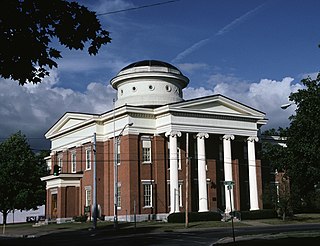
Belhurst Castle is a former private residence on the shores of Seneca Lake in Geneva, New York. It was designed by architects Fuller & Wheeler and built between 1885 and 1889. The three-story, nine bay wide Romanesque Revival style mansion is constructed of Medina sandstone. It has a slate gable roof, one-story solarium, and four rectangular stone chimneys. It features projecting porches, bays, towers with conical and pyramidal roofs, eyebrow windows, and a porte cochere with Syrian arch.
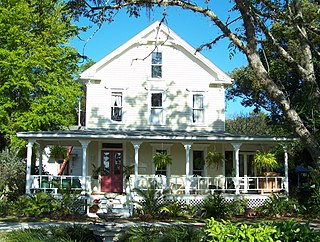
The Moses J. Taylor House, also known as the Dreamspinner Bed and Breakfast Inn, is a historic home in Eustis, Florida that has been operated as a bed and breakfast since about 1997. It was built in about 1881 as a two-and-a-half-story private home with elements of Italianate architecture. It was on a large property surrounded by citrus groves of the Taylor family until the land was split off for residential subdivisions built in the 1950s and 1960s.

The James B. Weaver House is a historic house at 102 Weaver Road in Bloomfield, Iowa. Built in 1865, it was the home of James Weaver (1833-1912) until 1890. Weaver, a populist and anti-monopolist, was the Greenback candidate for President in 1880 and the Populist candidate in 1892. The house was declared a National Historic Landmark in 1975. It is now operated as a bed and breakfast inn.

The Cleveland House is located in Versailles, Kentucky. Originally the Cleveland Orphan Home, it was an orphanage that incorporated in 1869, remaining in operation until the 1950s. The original 1875 house was made of brick in classic revival style architecture. The current structure was built in 1926, a 2½-story Dutch Colonial Revival building on the main foundation of the earlier house.

The Rudolph Latto House is a historic house in Hastings, Minnesota, United States, built 1880–1881. It is listed on the National Register of Historic Places for local significance in architecture for its transitional Italianate/Eastlake design. It was built in white Chaska brick.

Monterey Place, best known as the Shepard House, is a historic residence in Mobile, Alabama, United States. The house was designed by architect George Franklin Barber in 1897 for Charles Martin Shepard, the general passenger agent for the Mobile and Ohio Railroad in Mobile. Shepard's daughters, Kate and Isabel, began to use the house as a boarding school in 1910.

The Horace Munroe House is an historic house at 123 Pleasant Street in Auburn, Maine. Built in 1899-1900 to a design by William R. Miller, it is one of Auburn's finest examples of Queen Anne architecture. It was listed on the National Register of Historic Places in 1980. It is now the Munroe Inn, a bed and breakfast inn.

The Inn at 97 Winder is a luxurious historic Inn located at 97 Winder Street in Midtown Detroit, Michigan, within the Brush Park district. Originally known as the John Harvey House, it was listed on the National Register of Historic Places in 1991. The Detroit hotel is two blocks from Comerica Park and three blocks from Ford Field.

Samuel Lewis House in Mansfield, Ohio is a Greek revival building. It was listed on the National Register of Historic Places in 1982.

The historic Nelson County Jail in the Bardstown Historic District in Bardstown, Kentucky is a property on the National Register of Historic Places. It is next door to the Old Talbott Tavern.

James G. Marshall House is a historic home located at Niagara Falls in Niagara County, New York. It is a three-story Arts and Crafts style dwelling built in 1913 by the industrialist and inventor James G. Marshall (1869–1960). It was designed by prominent local architect Simon Larke, who also designed the Former Niagara Falls High School. In April 1994, it opened as a bed and breakfast.
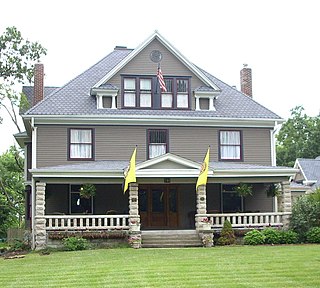
The John N. and Elizabeth Taylor House is a historic home in Columbia, Missouri which has been restored and once operated as a bed and breakfast. The house was constructed in 1909 and is a 2 1/2-story, Colonial Revival style frame dwelling. It features a wide front porch and side porte cochere. The home was featured on HGTV special called "If walls could talk."

The Breckwoldt-Ward House is a historic house located at 90 Van Buren Street in Dolgeville, Herkimer County, New York.

Notleymere (1885–89), also known as the Frank Norton estate, is a historic house located on the eastern shore of Cazenovia Lake in Cazenovia, Madison County, New York. The large, Shingle Style "summer cottage" was designed by architect Robert W. Gibson. It is a picturesque, asymmetrically massed, 3 1⁄2-story structure, sheathed in dark-stained wooden shingles and covered by a steeply pitched, multi-gabled, shingle roof. It features two tall, corbelled brick chimneys and a three-story polygonal turret.
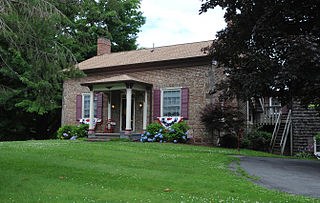
Preston-Gaylord Cobblestone Farmhouse is a historic home located at Sodus in Wayne County, New York. The cobblestone dwelling was built in 1845–1846, and consists of a 1 1/2-story main block and 1 1/2-story rear wing. Both sections are constructed of irregularly sized and variously colored field cobbles. Also on the property is a contributing two-story cobblestone carriage house dated to 1845–1846. The structure is among the approximately 170 surviving cobblestone buildings in Wayne County. The house is now used as a bed and breakfast known as the Maxwell Creek Inn Bed & Breakfast.

Robert L. Doughton House is a historic home located at Laurel Springs, Alleghany County, North Carolina It was built in 1899, and is a two-story frame farmhouse in a vernacular Queen Anne style influenced frame cottage. It features a steeply pitched hip roof, with a two-story, one-bay gable roof projection. It was the home of Robert L. Doughton (1863-1954), one of North Carolina's foremost politicians of the first of the 20th century. In the 1990s Rufus A. Doughton's house was restored, and it is now a popular bed-and-breakfast for tourists to the region.
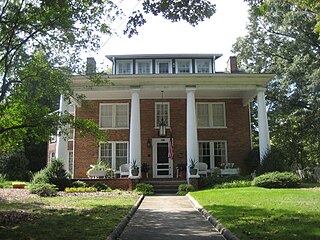
Bumpas-Troy House is a historic home located at Greensboro, Guilford County, North Carolina. It was built in 1847, and is a 2 1/2-story, three bay, Greek Revival style brick dwelling. The front facade features a two-story portico.

The Mary Lee Davis House is a historic house at 410 Cowles Street in Fairbanks, Alaska. It is now the Alaska Heritage House, a bed and breakfast inn. It is a 1-1/2 story bungalow-style house, set at the northern corner of Cowles and 5th Avenue in a residential area of the city. The exact construction date of the house is uncertain: it was probably complete by 1916, but construction may have begun as early as 1906; it is acknowledged as the city's oldest occupied residence. The unfinished house was purchased by writer Mary Lee Davis and her husband, who finished the building and added a number of its distinctive touches, including the city's first residential coal heating system. After a period of ownership by the Fairbanks Exploration Company, during which it was home to company executives, it went through a succession of owners before being converted to a bed and breakfast.
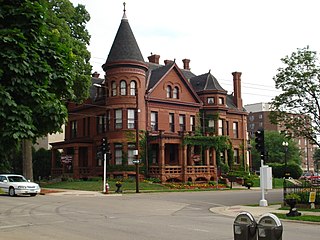
Redstone is a historic building located in Dubuque, Iowa, United States. This is one of three large homes that Augustine A. Cooper, who owned Cooper Wagon and Buggy Works, built for himself and his two daughters. When it was completed in 1888 it was a duplex with 27 rooms, with the family side more ornate than the tenant side. The 2½-story brick structure with red sandstone trim was designed by Thomas Carkeek in the Richardsonian Romanesque style. The elements of that style are found in the round arch window openings, the use of rough limestone for the lintels, and its heavy mass. The terracotta friezework on the cornices over the bay window, the tower, the corner gables, and the Corinthian-style capitals on the porch columns reflect Neoclassical influences. The house was individually listed on the National Register of Historic Places in 1976, and it was included as a contributing property in the Cathedral Historic District in 1985. The building has been converted into a bed and breakfast inn.
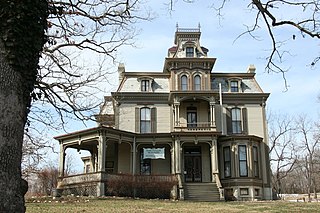
John Garth House, also known as Woodside Place, is a historic home located near Hannibal, Ralls County, Missouri. It was built about 1871, and is a 2 1/2-story, Second Empire style frame dwelling. It measures approximately 99 feet by 54 feet and sits on a limestone block foundation. It features mansard roofs, projecting tower, four porches, and two semi-octagonal bay windows. It was built as a summer home for John H. Garth a prominent local citizen of Hannibal, Missouri and friend of Samuel Clemens. It is operated as Garth Woodside Mansion Bed and Breakfast Inn.

